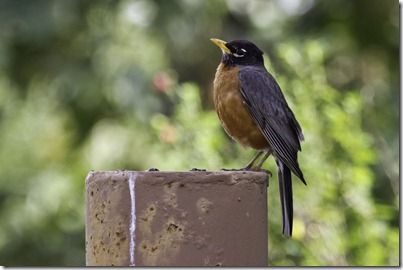Phil’s Photo Monday
AMERICAN ROBIN
Cool Facts
An American Robin can produce three successful broods in one year. On average, though, only 40 percent of nests successfully produce young. Only 25 percent of those fledged young survive to November. From that point on, about half of the robins alive in any year will make it to the next. Despite the fact that a lucky robin can live to be 14 years old, the entire population turns over on average every six years.
Although robins are considered harbingers of spring, many American Robins spend the whole winter in their breeding range. But because they spend more time roosting in trees and less time in your yard, you’re much less likely to see them. The number of robins present in the northern parts of the range varies each year with the local conditions.
Robins eat a lot of fruit in fall and winter. When they eat honeysuckle berries exclusively, they sometimes become intoxicated.
Robin roosts can be huge, sometimes including a quarter-million birds during winter. In summer, females sleep at their nests and males gather at roosts. As young robins become independent, they join the males. Female adults go to the roosts only after they have finished nesting.
Robins eat different types of food depending on the time of day: more earthworms in the morning and more fruit later in the day. Because the robin forages largely on lawns, it is vulnerable to pesticide poisoning and can be an important indicator of chemical pollution.
The oldest recorded American Robin was 13 years and 11 months old.
Habitat
Open Woodland
American Robins are common birds across the continent. You’ll find them on lawns, fields, and city parks, as well as in more wild places like woodlands, forests, mountains up to near treeline, recently burned forests, and tundra. During winter many robins move to moist woods where berry-producing trees and shrubs are common.
Food
Insects
American Robins eat large numbers of both invertebrates and fruit. Particularly in spring and summer they eat large numbers of earthworms as well as insects and some snails. (They have rarely been recorded eating shrews, small snakes, and aquatic insects.) Robins also eat an enormous variety of fruits, including chokecherries, hawthorn, dogwood, and sumac fruits, and juniper berries. One study suggested that robins may try to round out their diet by selectively eating fruits that have bugs in them.
Nesting
Nesting Facts
Clutch Size
3–5 eggs
Number of Broods
1-3 broods
Egg Length
1.1–1.2 in
Egg Width
0.8 in
Incubation Period
12–14 days
Nestling Period
13 days
Egg Description
Sky blue or blue-green and unmarked.
Condition at Hatching
Helpless at birth, mostly naked with spare whitish down.
Nest Description
Females build the nest from the inside out, pressing dead grass and twigs into a cup shape using the wrist of one wing. Other materials include paper, feathers, rootlets, or moss in addition to grass and twigs. Once the cup is formed, she reinforces the nest using soft mud gathered from worm castings to make a heavy, sturdy nest. She then lines the nest with fine dry grass. The finished nest is 6-8 inches across and 3-6 inches high.
Nest Placement
Tree
Female robins choose the nest sites, which are typically on one or several horizontal branches hidden in or just below a layer of dense leaves. Nests are typically in the lower half of a tree, although they can be built as high as the treetop. American Robins also nest in gutters, eaves, on outdoor light fixtures, and other structures. In western prairies, American Robins may build their nests on the ground or in thickets, while in Alaska they sometimes nest on buildings or cliffs.
Behavior
Ground Forager
When foraging on the ground, the American Robin runs a few steps, then stops abruptly. In long grass, robins may hop or fly just above the ground powered by slow, powerful wingbeats. American Robins often find worms by staring, motionless, at the ground with the head cocked to one side. Robins sometimes fight over worms that others have caught. During fall and winter robins often roost in large flocks and spend much more time in trees. In spring, males attract females by singing, raising and spreading their tails, shaking their wings and inflating their white-striped throats. When pairs are forming in spring, you may see a display in which a male and female approach each other holding their bills wide open and touching them. American Robins are strong, straight, and fast fliers.
Conservation
status via IUCN
Least Concern
Populations appear stable or increasing throughout range. Because the robin forages largely on lawns, it is vulnerable to pesticide poisoning and can be an indicator of chemical pollution.
Source: http://www.allaboutbirds.org/guide/American_Robin/lifehistory

 (916) 434-2759
(916) 434-2759



